Commander’s in a pretty great place right now. Anyone looking to enter this Vintage-lite format can do so pretty easily, choose from a huge variety of strategies, and quickly have a deck they are able to take to a local game store or friend’s house for a day of fun and camaraderie.
Well…maybe not that last one just yet, though online options like a Spelltable webcam setup or untap.in have certainly made remote play easier to coordinate.
All of this is what initially attracted me to the format and has kept me interested over the years. I love getting to play crazy, powerful cards and carefully tuning decks to function like well-oiled machines.
I dedicate years to learning the ins and outs of my favorite strategies, and ultimately end up collecting foils for the decks I decide to keep for the long term. Few things throw these years of practice and entire games’ worth of preparation into disarray as efficiently as the 7 mana instant we know and loathe as Cyclonic Rift.
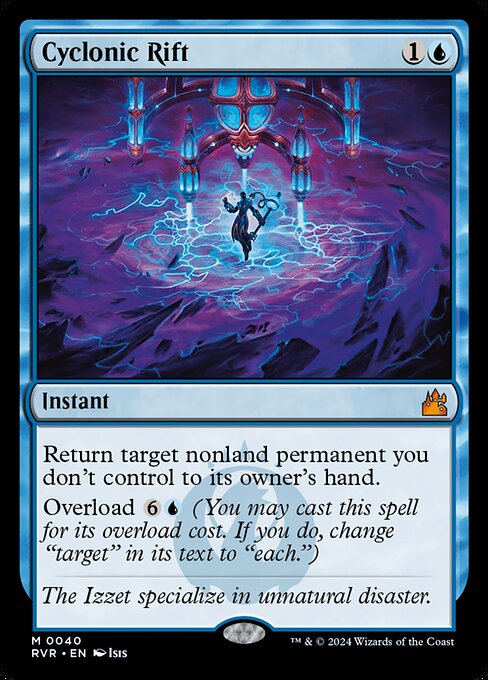
In a world where you can play cards of such legendary power as Bazaar of Baghdad, Mishra’s Workshop, and Timetwister, it feels a little weird that a relative newcomer is so comparatively despised. Cyclonic Rift doesn’t have the same potential to propel you ahead of your opponents in early turns, costs a lot of mana to get its best effect, and doesn’t permanently deal with anything in play except tokens.
So what exactly does it do that makes it so obnoxious to many? Let’s start by breaking down what Cyclonic Rift does do for you:
- You can cast Cyclonic Rift offensively AND defensively to great effect
- There are comparatively few ways to defend against Cyclonic Rift‘s Overload effect
- Cyclonic Rift‘s low base casting cost gives it considerable flexibility over a regular 7 mana spell
- Cyclonic Rift is more efficient than similar cards that are legal in Commander
- Any deck with blue (exempting cEDH decks, and sometimes even then) is almost always made better by playing Cyclonic Rift due to the above
That’s quite a resume, and one that has proven itself for and against me many times since it was released. If you’re among the lucky few who hasn’t had to experience Cyclonic Rift, however, I’ve got you covered. We’re going to go over each of these strengths in detail, then use that information to answer my original question: Should Cyclonic Rift be banned in Commander?
Cyclonic Rift is an Incredible Card On Offense and Defense
The Commander game is entering its second hour. Life totals are getting low, and the board is deadlocked due to powerful threats checking and balancing each other from all players. You look around the battlefield, looking for some way to get your creatures through opposing defenses to close the game, but there aren’t any good openings.
Agonizing, you draw for your turn and pick up a Cyclonic Rift. Suddenly all calculations not revolving around instants (or cards with Flash) are rendered meaningless, and given the current state of the game, it is unlikely anyone else has a suitable answer. You make the play, clear every nonland permanent that isn’t under your control off the field, and attack your now defenseless opponents for the win.
At first glance, this seems like an idealized situation some would call Magical Christmas Land, but in reality, this couldn’t be further from the truth. I’ve personally watched and played in an incredible number of Commander games that were decided on the spot for one or more players because this card wiped out all defenses and cleared a path for attacking creatures.
Even if another player at the table was willing to defend you with a card effect they had in play, they can no longer do so because that effect is now locked away in their hand.
Going back to our earlier game, let’s change the circumstances a bit and assume that you’re in the weakest board position of the players at the table. One of your opponents has a few creatures, and they cast an Overwhelming Stampede, thinking they’ve got lethal damage on the board.
Having had nothing better to do than draw your card last turn, you use 7 of the mana you couldn’t spend on advancing your board to cast Cyclonic Rift. Suddenly, the player trying to win the game has to start rebuilding their battlefield with access to 5 less mana (since that was spent on Overwhelming Stampede), and your other opponents have to spend at least a turn rebuilding too.
This generally means 1 of 2 things for you. Either you’re going to be giving yourself considerable breathing room to catch up to the other players in terms of board state, or you’ve been able to get far enough ahead to try closing the game yourself. Where you fall on this scale will vary from game to game, but Cyclonic Rift will open doors for you in games that had firmly closed them before.
It is Incredibly Difficult to Block a Cyclonic Rift
When an overloaded Cyclonic Rift comes down, you have limited ways to deal with it. Since it’s a bounce spell that hits everything without targeting, cards like Ghostway only work in a limited capacity since it only exiles creatures, and cards that provide Shroud, Hexproof, or Indestructible simply won’t protect you. Options do exist though, so here’s a quick primer on ways you can prepare your deck for Cyclonic Rift:
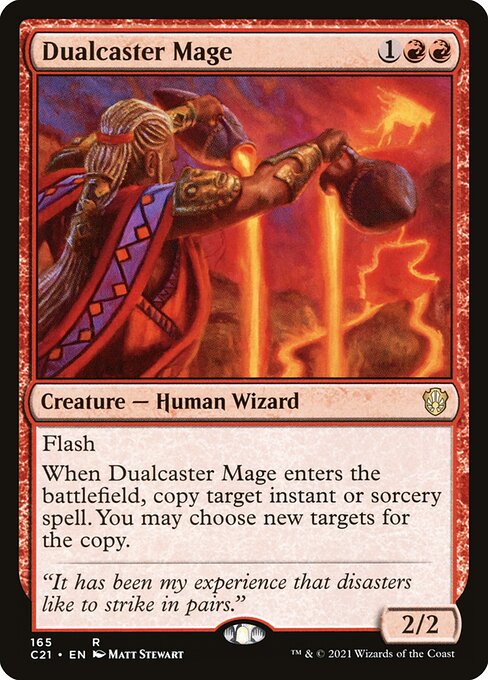



- If you copy Cyclonic Rift, the caster is set back along with the rest of the table, mitigating or negating their advantage
- Countering Cyclonic Rift keeps it from hitting the table in the first place, and will almost always cost you less mana and tempo than the caster
- Removing Cyclonic Rift from an opposing deck will prevent its owner from drawing and casting it
- When in doubt, ask “What would Teferi do?”
Most cards capable of doing these things don’t see extensive play at casual Commander tables (Teferi’s Protection being the primary exception), so it is easy to feel like there is nothing you can do against the might of a Cyclonic Rift.
It’s also important to note that including these cards in your deck isn’t guaranteed to stop Cyclonic Rift every game, and adding too many of these silver bullets can detract from your strategy too. Having a few options is certainly better than none at all though, and all of these cards have the opportunity to do you some good in other situations as well.
If you would rather not change your deck to deal with Cyclonic Rift, getting an extra attack or two in on the blue player can make it easier to bring them down if and when they set you back.
Metagame knowledge can help you determine how much extra damage is reasonable for keeping a player’s deck in check, and if you’re playing against someone new who is demonstrating access to powerful cards and advanced tactics, better to use too much force than not enough in addressing the unknown.
Cyclonic Rift is Only a 7 Mana Spell in Application – Not as Printed
I’ve exclusively referred to Cyclonic Rift as a 7 mana spell, but as printed on the card, its converted mana cost (CMC) is 2. For this lesser mana cost, you are able to return a single nonland permanent an opponent controls back to their hand, which is great in an emergency because this card isn’t sitting uselessly in your hand until mid-late game. The lower base cost also allows Cyclonic Rift to interact differently with other cards than those with a base CMC of 7.
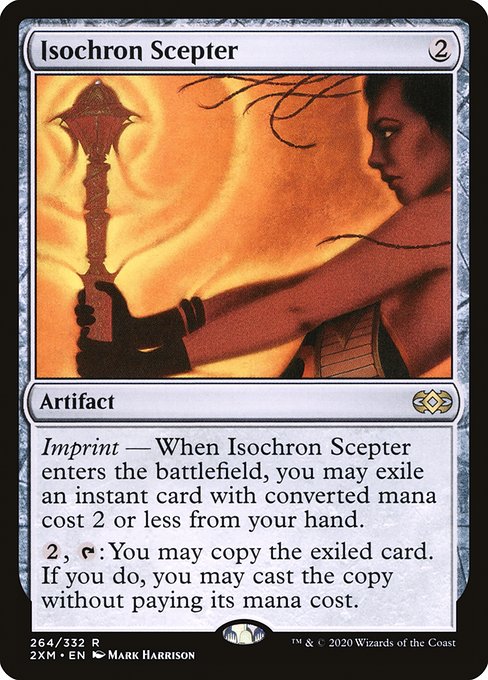
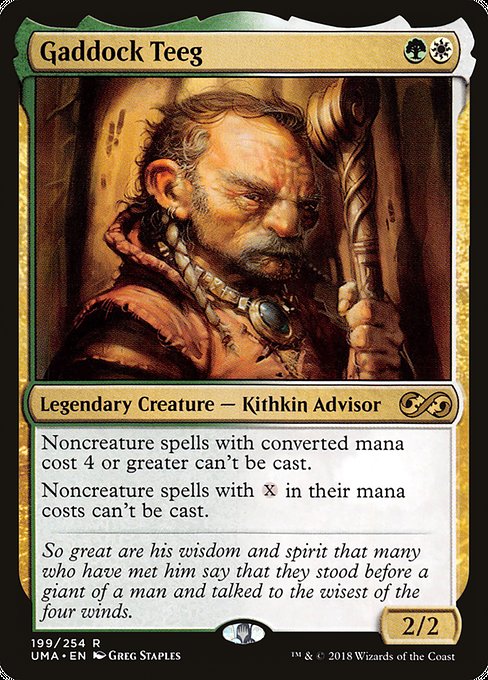
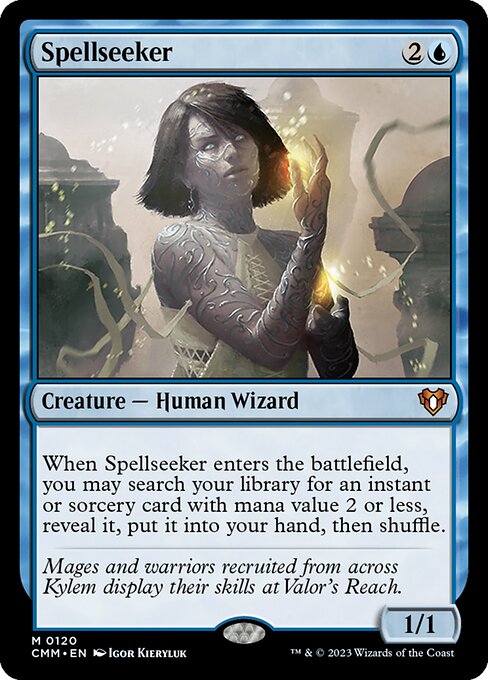

For the most part, these interactions are very beneficial. Being able to wipe the board despite the presence of Gaddock Teeg is one of the cooler examples I could come up with (as Teeg only cares about the cost printed in the upper right corner of the card), but the flip side of that coin is that there are a few extra vulnerabilities that can crop up with cards like Spell Queller too.
Spellseeker also offers an extremely convenient way to add Cyclonic Rift to a toolbox of other inexpensive spells, and I’d be lying if I told you I haven’t taken advantage of this to completely turn a game around out of nowhere.
Cyclonic Rift’s Power Level Compares Favorably With Its Peers
That’s a bold statement without some explanation, so let’s take a look at a few cards in the same weight class.
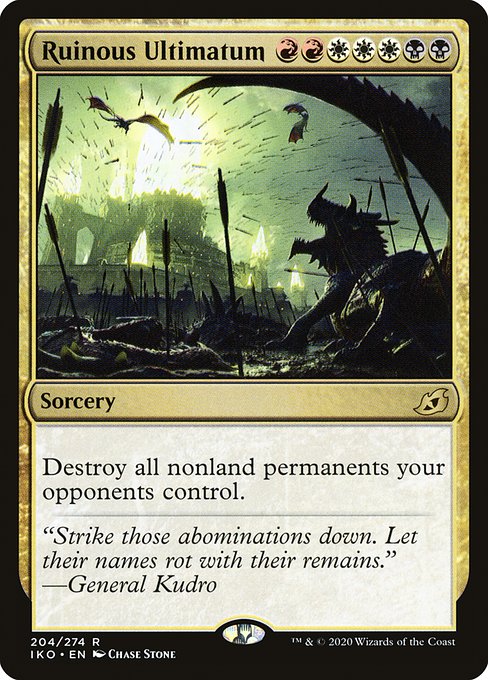

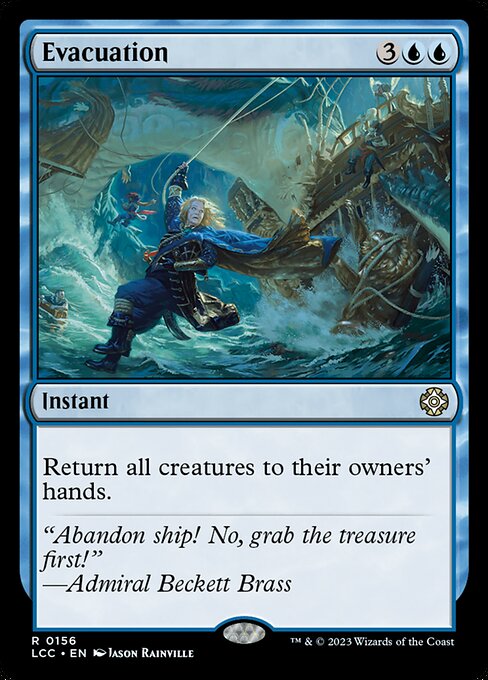

The recent release of Ruinous Ultimatum is what really got me thinking about this point and putting it into perspective. We touched on this earlier, but destroying cards and returning them to a player’s hand are two very different things.
Cards that have or give Indestructible are capable of defending against destruction effects, opening up quite a few options when it comes to preparing for or recovering from from a mass removal effect.
Heroic Intervention and Boros Charm see a lot of play already, as do cards like Darksteel Plate, the Theros/Amonkhet gods, and big threats like Ulamog, the Infinite Gyre. You can also bring cards that were destroyed back from the graveyard with cards like Eternal Witness, Reanimate and Eerie Ultimatum, further expanding your list of potential answers.
Sure, Ruinous Ultimatum will still blow out its share of games, but in addition to having more foils, the mana requirements are steep. 7 specifically colored mana means Ruinous Ultimatum will show up in a fraction of the decks Cyclonic Rift does AND it will require the right lands to have shown up by the time you need to cast it.
No splashing this in every deck with one specific color, no guarantees of being a complete screen nuke against your opponents, and you have to cast it at sorcery speed. Definitely a drop in power, flexibility, and accessibility compared to Cyclonic Rift, making Ruinous Ultimatum a much more balanced card overall.
River’s Rebuke and Evacuation each offer most of what Cyclonic Rift does, but that bit they’re missing dramatically lowers their power level and flexibility. River’s Rebuke will completely strip one opponent’s field – but only one, and at sorcery speed.
Evacuation has the instant speed nature of Cyclonic Rift, but is limited to creatures and bounces your cards too. It also has the widest gap in power compared to Cyclonic Rift of my examples because it is one of the only other mass bounce effects available at instant speed. That should speak volumes all by itself.
Lastly we have Upheaval. The line in the sand, the bridge too far, Upheaval has been banned for years in Commander. Despite being symmetrical in terms of who it affects, it has the added benefit of returning lands in addition to other permanents.
Despite being a sorcery, you can easily set this up in a one-sided way that leaves you with powerful threats on the board while clearing everyone else’s out. Without lands, there won’t be anything they can do about it on subsequent turns either.
This lasting impact is almost certainly why Upheaval is banned while Cyclonic Rift is not. It’s an interesting distinction, but the boundary often blurs if the caster only needs a one-turn window to lock up the game or if their opponents simply can’t replay everything they have built up over the course of several turns.
Being able to cast Cyclonic Rift during the end step right before your turn also ensures you have access to all of your mana while your opponents are at varying degrees of being tapped out, creating a similar, if shorter lived, experience to that created by Upheaval.
We’ve Established Why Cyclonic Rift is so Powerful – But Should it be Banned?
The Commander Rules Committee has been pretty clear about their philosophy in the past, so using the information I’ve laid out here, we’re going to try and fit Cyclonic Rift into this rubric. Since the link in their FAQ is broken, you can either use my earlier link or read on to see the standard we’ll be using to judge this question, as written by Sheldon Menery of the Rules Committee.
The Philosophy of Commander
Commander is for fun. It’s a socially interactive, multiplayer Magic: the Gathering format full of wild interactions and epic plays, specifically designed as an alternative to tournament Magic. As is fitting for a format in which you choose an avatar to lead your forces into battle, Commander focuses on a resonant experience. Each game is a journey the players share, relying on a social contract in which each player is considerate of the experiences of everyone involved–this promotes player interaction, inter-game variance, a variety of play styles, and a positive communal atmosphere. At the end of an ideal Commander game, someone will have won, but all participants will have had the opportunity to express themselves through their deck building and game play.The rules of Commander are designed to maximize these experiences within a game of Magic. The addition of a commander, larger life total, and deck building restrictions emphasize the format’s flavor; they increase deck variance and add more opportunities for participation and expression.
The goal of the ban list is similar; it does not seek to regulate competitive play or power level, which are decisions best left to individual play groups. The ban list seeks to demonstrate which cards threaten the positive player experience at the core of the format or prevent players from reasonable self-expression. The primary focus of the list is on cards which are problematic because of their extreme consistency, ubiquity, and/or ability to restrict others’ opportunities.
No single rule can establish criteria for a ban; there are many mitigating or exacerbating factors. Some cards will represent an extreme on a single axis; others are a confluence of multiple smaller issues. The following list isn’t exhaustive, nor is it a checklist, but it represents ways in which cards challenge the positive experiences players look for in commander games. It includes cards which easily or excessively
• Cause severe resource imbalances
• Allow players to win out of nowhere
• Prevent players from contributing to the game in a meaningful way.
• Cause other players to feel they must play certain cards, even though they are also problematic.
• Are very difficult for other players to interact with, especially if doing so requires dedicated, narrow responses when deck-building.
• Interact poorly with the multiplayer nature of the format or the specific rules of Commander.
• Lead to repetitive game play.Cards which are banned likely meet a few of these criteria in a significant way; not all cards which meet some of the criteria need to banned.
We prefer to be conservative with what goes on or comes off the ban list. Commander players often become emotionally attached to their decks through play and personalization, and we value that experience highly. We only want to disrupt that bond when necessary.
Commander is designed to be a malleable format. We encourage groups to use the rules and the ban list as a baseline to optimize their own experience. This is not license for an individual to force their vision onto a play group, but encouragement for players to discuss their goals and how the rules might be adjusted to suit those goals. The format can be broken; we believe games are more fun if you don’t.
-Sheldon Menery, July 08, 2019
Probably more information than you wanted, but leaving any of it out felt a little disingenuous for my analysis. If you want the TL;DR version, I’m primarily going to use the supplied bulleted list for my evaluation. I’m also going to add some additional thoughts as I answer whether Cyclonic Rift does what is being asked.
- Cause severe resource imbalances (No, if referring to mana. Yes, if referring to other types of nonland cards)
- Allow players to win out of nowhere (Yes, on a slightly lesser scale than Upheaval)
- Prevent players from contributing to the game in a meaningful way. (Yes, on the grounds that Cyclonic Rift erases up to a full game’s worth of progress for all opponents)
- Cause other players to feel they must play certain cards, even though they are also problematic. (No. I’ve not heard of anyone adding cards to their deck specifically to combat Cyclonic Rift)
- Are very difficult for other players to interact with, especially if doing so requires dedicated, narrow responses when deck-building. (Yes – while the answers to Cyclonic Rift I discussed earlier do have other uses, most exist in a fairly narrow area of application)
- Interact poorly with the multiplayer nature of the format or the specific rules of Commander. (No)
- Lead to repetitive game play. (No. While the consequences of a Cyclonic Rift are often very similar in nature, decks traditionally do not revolve around casting this specific card as a win condition.)
This is honestly a tough call. By comparison, Upheaval solidly ticks all the same boxes as Cyclonic Rift, plus it more thoroughly qualifies for bullet 1. It almost certainly ticks bullets 4 and 7 to a certain degree too, so it is definitely the more egregious card. Thinking on this a little further and rereading the philosophy a few times, I’m also of the mind that some of these bullets count more than others – specifically 1, 3, 4, and 5.
These deal most with the shared gameplay experience of a Commander game, so I’m going to take the liberty of valuing them more highly than the others in deciding my answer to whether Cyclonic Rift should be banned.
Don’t get me wrong – 2, 6, and 7 matter too, but 2 and 7 only seem problematic in tandem, and 6 really operates independently of the other factors – I’d even say a card has to solidly pass point 6 before other factors are reviewed. I also acknowledge this list of criteria is not intended to be comprehensive – but it’s the closest thing to hard and fast rules we have.
So, if I had the authority to ban this card from Commander, would I?
Absolutely.
Cyclonic Rift firmly ticks over half of the most important criteria for a ban as I see it, and it also merits consideration in an additional capacity of slightly lesser importance. It is easily the most powerful and flexible mass bounce spell in the format, which while not worthy of a ban in its own right, has led to an ubiquity that cannot be denied in decks playing blue.
It renders large portions of a Commander game meaningless by sweeping all opposing nonland permanents off the field and simultaneously puts you ahead by leaving your cards untouched. Your opponents are then left with the decision of whether to replay their cards or put out new threats, and the former is often just not doable over the course of a single turn.
Assuming they survive to see it.
There’s also one other really important fact that led me to this conclusion. People, in my experience, hate Cyclonic Rift. It almost always elicits a negative response when Overloaded because the players being hit by it are being dramatically set back and subtly being told their earlier actions did not matter.
It also grinds plans to a halt for the majority of the table and feels like a must-include when building any deck with blue because it is often the ultimate answer to questions like “How can I clear a path to win?”, “How can I get ahead in this game?”, and “How can I stop myself from losing for at least 1 more turn?”.
Despite these negative traits, Cyclonic Rift has also managed to avoid the same type of stigma as cards like Armageddon, so Commander’s social contract holds less sway over the decision of whether you should play it.
No part of this supports the idea of a positive player experience, but it does consistently reek of ubiquity and restriction of others’ opportunities.
All of that being said, I also understand why the Rules Committee hasn’t swung the banhammer at Cyclonic Rift. It isn’t as egregious as other entries on the banned list. It doesn’t tick quite as many of the banning criteria. There’s substantial secondary market value at this point, which caused a lot of player consternation during the banning of the then expensive Paradox Engine.
The Rules Committee’s stated philosophy encourages keeping problematic cards out of games through use of Commander’s social contract. To practice what is being preached, a laissez-faire approach toward managing the format is ideal so the social contract can function. All of this makes sense, and I understand their point of view and hesitance to act here.
We just happen to disagree on how to proceed when it comes to addressing this specific card. And that’s okay – Commander will continue to be awesome even with Cyclonic Rift in it, and that’s what matters most.
Whether you agree or disagree with Cyclonic Rift’s continued legality or my views on the matter, thanks very much for reading! If you want to chat with me more about this topic, consider joining our Patreon to get access to the Assorted Meeples Discord!
We have a great community that loves talking all things gaming, and you can get in on that for as little as $1 per month. We also put out additional content for Patrons and often invite them to play video games with us on our Twitch streams, so what are you waiting for?
Braden is a founder of Assorted Meeples and has been a gamer & writer with a vivid imagination all his life. Don’t believe us? Check out his excitement when meeting Goosebumps author R.L. Stine as a kid! An avid Magic: The Gathering spellslinger for over 15 years, you can always convince him to shuffle up for a game (or three!) of Commander.
